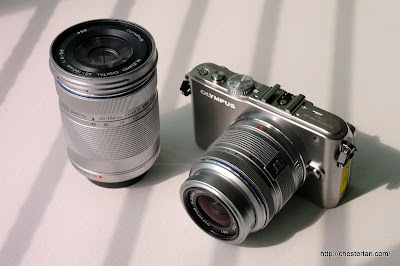Olympus has announced 3 interchangeable lens cameras (ILC) at one go - the big-brother E-P3, the "lite" E-PL3, and the "mini" E-PM1. For this review, I had my hands on the E-PL3 for a week.
First Impressions
At 313g, the 12-megapixel E-PL3 is one of the heaviest ILC in its class. The camera feels very solid, and the design continues to be influenced by the retro rangefinders. But I felt that the rear panel design layout needs to be further optimised. The articulated screen is too thick and slightly hinders the operations of the hardware buttons surrounding it.
The lenses provided for the review are the kit lens 14-42mm and 40-150mm. Both are entirely in plastic, extremely lightweight and I wouldn't drop them on hard surfaces. The 14-42mm requires you to extend the lens before you can start shooting, and you can see from the photo below that the lens extends a lot. Fortunately, the optic quality is good enough for general shooting.
Interface
E-PL3 has got to be one of the most customisable compact cameras. Olympus has dedicated one custom menu with 10 sub-sections to let you alter the button operations to your hearts content. Even this menu can be customised not to show on the main menu! I won't go into details, but if you are a user who desires to control whether you turn the focus ring clockwise or anti-clockwise, or whether you want your medium size file to be 8MP or 5MP, the E-PL3 will satisfy you. The drawback with all the customisation is that a fellow E-PL3 user would find it hard to operate your E-PL3 camera. Do also note that the editable menu items depend on the mode (iAuto, PASM, etc.) you select on the mode dial. And you are unable to save the settings you painstakingly configured.
Shooting Speed
The E-PL3 has rather snappy AF speed under adequate light. But under low light conditions, AF speed takes a beating, and sometimes doesn't focus correctly. Shot-to-shot is very responsive, but a fast SD card is recommended if you require long continuous shooting performance.
Image Quality
In terms of noise, the E-PL3 allows you to customise the level of noise reduction and filter. I personally prefer images in "Off" or "Low" setting, as I find the "Standard" setting too muddy for my preference. I am happy to capture images at ISO 3200.
Video Quality
From the video samples I recorded, I observe that the E-PL3 exhibits the "rolling shutter" effect, so I wouldn't use it for any serious projects. Low-light video recording - even at ISO 3200 - is just as good as the still images.
Final Words
The key advantages of the E-PL3 over the competitors are its premium-looking retro design, the ability to customise the camera functions to meet your shooting requirements, and good noise handling at high ISO (when noise filter is set to "low"). The camera is generally responsive in keeping up with my shot-to-shot demands, but the interface has a slight lag when invoking the menu items. Its solid build gives you assurance that it can take some rough handling, but the plastiky kit lenses could be the weakest link.
Labels: Camera, Review, Tech
